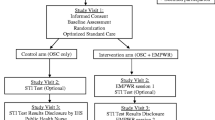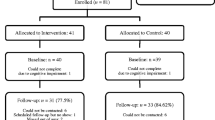Abstract
We evaluated the efficacy of a gender-specific intervention to reduce sexual risk behaviors by introducing female-initiated methods to urban women with severe mental illness. Seventy-nine women received 10 sessions of an HIV prevention intervention or a control intervention. The primary outcome was unprotected oral, anal, or vaginal intercourse, expressed using the Vaginal Episode Equivalent (VEE) score. Knowledge and use of the female condom were also assessed. Women in the HIV prevention intervention showed a three-fold reduction in the VEE score at the 3-month follow-up compared to the control group, but the difference was not significant. These women were significantly more likely to know about female condoms, have inserted one and used it with a sexual partner at the 3-month follow-up and to have inserted it at 6 months compared to controls. The female condom may be a useful addition, for a subset of women with SMI, to comprehensive HIV prevention programs.

Similar content being viewed by others
References
Amaro, H. (1995). Love, sex, and power: Considering women’s realities in HIV prevention. American Psychologist, 50, 437–447.
Amaro, H., & Ray, A. (2000). On the margin: Power and women’s HIV risk reduction strategies. Sex Roles, 42(7/8), 723–749.
Bandura, A. (1994). Social cognitive theory and exercise control of HIV infection. In R. J. DiClemente & J. L. Peterson (Eds.), Preventing AIDS: Theories and methods of behavioral interventions (pp. 25–59). New York: Plenum Press.
Blank, M. B., Mandell, D. S., Aiken, L., & Hadley, T. R. (2002). Co-occurrence of HIV and serious mental illness among medicaid recipients. Psychiatric Services, 53(7), 868–873.
Carey, M. P., Carey, K. B., Maisto, S. A., Gordon, C. M., Schroder, K. E. E., & Vanable, P. A. (2004). Reducing HIV-risk behavior among adults receiving outpatient psychiatric treatment: Results from a randomized clinical trial. Journal of Consulting and Clinical Psychology, 72(2), 252–268.
Coates, T. J., Richter, L., & Caceres, C. (2008). Behavioral strategies to reduce HIV transmission: How to make them work better. The Lancet, 372, 669–684.
Collins, P. Y., Elkington, K. S., von Unger, H., Sweetland, A., Wright, E. R., & Zybert, P. (2008a). The relationship of stigma to HIV risk behavior among women with mental illness. American Journal of Orthopsychiatry, 78(4), 498–506.
Collins, P. Y., Geller, P. A., Miller, S., Toro, P., & Susser, E. (2001). Ourselves, Our Bodies, Our Realities: An HIV preventive intervention for women with mental illness. Journal of Urban Health, 78(1), 162–175.
Collins, P. Y., von Unger, H., & Armbrister, A. (2008b). Church ladies, good girls, and locas: Stigma and the intersection of ethnicity, gender, mental illness, and sexuality. Social Science & Medicine, 67, 389–397.
Devieux, J. G., Malow, R., Lerner, B. G., & Dyer, J. G. (2007). Triple jeopardy for HIV: Substance using severely mentally ill adults. Journal of Prevention & Intervention in the Community, 33(1/2), 5–18.
Elkington, K. S., McKinnon, K., Mann, C. G., Collins, P. Y., Leu, C.-S., & Wainberg, M. L. (2010). Perceived mental illness stigma and HIV risk behaviors among adult psychiatric outpatients in Rio de Janeiro, Brazil. Community Mental Health Journal, 46(1), 56–64. doi: 10.1007/s10597-009-9209-4.
Exner, T. M., Seal, D., & Ehrhardt, A. (1997). A review of HIV interventions for at-risk women. AIDS and Behavior, 1(2), 93–124.
Fullilove, M., Fullilove, R., Haynes, K., & Gross, S. (1990). Black women and AIDS prevention: A view towards understanding the gender rules. The Journal of Sex Research, 27(1), 47–64.
Gollub, E. (2000). The female condom: Tool for women’s empowerment. American Journal of Public Health, 90, 1377–1381.
Gollub, E., French, P., Latka, M., Rogers, C., & Stein, Z. (2001). Achieving safer sex with choice: Studying a women’s sexual risk reduction hierarchy in an STD clinic. Journal of Women’s Health and Gender-Based Medicine, 10(8), 771–783.
Hardwick, D. (2002). The effectiveness of a female condom intervention on women’s use of condoms. The Canadian Journal of Human Sexuality, 11(2), 63–76.
Hirky, A. E., Kirshenbaum, S. B., Melendez, R. M., Rollet, C., Perkins, S. L., & Smith, R. A. (2003). The female condom: Attitudes and experiences among HIV-positive heterosexual women and men. Women and Health, 37(1), 71–89.
Holmes, L., Ogungbade, G. O., Ward, D. D., Garrison, O., Peters, R. J., Kalichman, S. C., et al. (2008). Potential markers of female condom use among inner city African American women. AIDS Care, 20(4), 470–477.
Kalichman, S., Malow, R., Devieux, J., Stein, J. A., & Piedman, F. (2005). HIV risk reduction for substance-using mentally-ill adults: Test of the Information-Motivation-Behavior Skills (IMB) model. Community Mental Health Journal, 41(3), 277–290.
Klein, H., Eber, M., Crosby, H., Welka, D. A., & Hoffman, J. A. (1999). The acceptability of the female condom among substance-using women in Washington, DC. Women and Health, 29(3), 97–115.
Kloos, B., Gross, S. M., Meese, K. J., Meade, C. S., Doughty, J. D., Hawkins, D. D., et al. (2005). Negotiating risk: Knowledge and use of HIV prevention by persons with serious mental illness living in supportive housing. American Journal of Community Psychology, 36(3–4), 357–372.
Krakow, D. S., Galanter, M., Dermatis, H., & Westreich, L. M. (1998). HIV risk factors in dually diagnosed patients. American Journal on Addictions, 7(1), 74–80.
Macaluso, M., Demand, M., Artz, L., Fleenor, M., Robey, L., Kelaghan, J., et al. (2000). Female condom use among women at high risk of sexually transmitted disease. Family Planning Perspectives, 32(3), 138–144.
Mays, V., & Cochran, S. (1988). Issues in the perception of AIDS risk and risk reduction activities by Black and Hispanic/Latina women. American Psychologist, 43(11), 949–957.
McKinnon, K., Cournos, F., Meyer-Bahlburg, H., Guido, J., Caraballo, L., Margoshes, E., et al. (1993). Reliability of sexual risk behavior interviews with psychiatric patients. American Journal of Psychiatry, 150(6), 972–974.
McKinnon, K., Cournos, F., & Herman, R. (2001). A lifetime alcohol or other drug use disorder and specific psychiatric symptoms predict sexual risk for HIV infection among people with severe mental illness. AIDS and Behavior, 5(3), 233–240.
McKinnon, K., Cournos, F., & Herman, R. (2002). HIV among people with chronic mental illness. Psychiatric Quarterly, 73(1), 17–31.
Meade, C. S. (2006). Sexual risk behavior among persons dually diagnosed with severe mental illness and substance use disorder. Journal of Substance Abuse Treatment, 30(2), 147–157.
Meade, C. S., Kershaw, T. S., Hansen, N. B., & Sikkema, K. J. (2009). Long-term correlates of childhood abuse among adults with severe mental illness: Adult victimization, substance abuse, and HIV sexual risk behavior. AIDS and Behavior, 13(2), 207–216.
Meade, C. S., & Sikkema, K. J. (2005). HIV risk behavior among adults with severe mental illness: A systematic review. Clinical Psychology Review, 25(4), 433–457.
Meade, C. S., & Sikkema, K. J. (2007). Psychiatric and psychosocial correlates of sexual risk behavior among adults with severe mental illness. Community Mental Health Journal, 43(2), 153–169.
Meyer-Bahlburg, H., Ehrhardt, A., Exner, T. M., & Gruen, R. S. (1991). Sexual risk behavior assessment schedule—Adult—Armory interview. New York: New York State Psychiatric Institute and Columbia University.
Otto-Salaj, L., Heckman, T., Stevenson, L., & Kelly, J. (1998). Patterns, predictors and gender differences in HIV risk among severely mentally ill men and women. Community Mental Health Journal, 34(2), 175–190.
Otto-Salaj, L., Kelly, J., Stevenson, L., Hoffmann, R., & Kalichman, S. (2001). Outcomes of a randomized small-group HIV prevention intervention trial for people with serious mental illness. Community Mental Health Journal, 37(2), 123–143.
Parry, C. D., Blank, M. B., & Pithey, A. L. (2007). Responding to the threat of HIV among persons with mental illness and substance abuse. Current Opinion in Psychiatry, 20(3), 235–241.
Pulerwitz, J., Amaro, A., Jong, W. D., Gortmaker, S., & Rudd, R. (2002). Relationship power, condom use and HIV risk among women in the USA. AIDS Care, 14(6), 789–800.
Randolph, M. E., Pinkerton, S. D., Somlai, A. M., Kelly, J. A., McAuliffe, T. L., Gibson, R. H., et al. (2007). Severely mentally ill women’s HIV risk: The influence of social support, substance use, and contextual risk factors. Community Mental Health Journal, 43(1), 33–47.
Rosenberg, S. D., Goodman, L. A., Osher, F. C., Swartz, M. S., Essock, S. M., Butterfield, M. I., et al. (2001a). Prevalence of HIV, Hepatitis B, and Hepatitis C in people with severe mental illness. American Journal of Public Health, 91(1), 31–37.
Rosenberg, S. D., Trumbetta, S. L., Mueser, K. T., Goodman, L. A., Osher, F. C., Vidaver, R. M., et al. (2001b). Determinants of risk behavior for Human Immunodeficiency Virus/Acquired Immunodeficiency Syndrome in people with severe mental illness. Comprehensive Psychiatry, 42(4), 263–271.
Sly, D., Quadagno, D., Harrison, D. F., Eberstein, I. W., Riehman, K., & Bailey, M. (1997). Factors associated with use of the female condom. Family Planning Perspectives, 29, 181–184.
Sohler, N., Colson, P. W., Meyer-Bahlburg, H. F. L., & Susser, E. (2000). Reliability of self-reports about sexual risk behavior for HIV among homeless men with severe mental illness. Psychiatric Services, 51(6), 814–816.
Susser, E., Desvarieux, M., & Wittkowski, K. M. (1998). Reporting sexual risk behavior for HIV: A practical risk index and a method for improving risk indices. American Journal of Public Health, 88(4), 671–674.
Vanable, P. A., Carey, M. P., Carey, K. B., & Maisto, S. A. (2006). Differences in HIV-related knowledge, attitudes, and behavior among psychiatric outpatients with and without a history of a sexually transmitted infection. Journal of Prevention and Intervention in the Community, 33(1–2), 79–94.
Walkup, J., Blank, M. B., Gonzalez, J. S., Safren, S., Schwartz, R., Brown, L., et al. (2008). The impact of mental health and substance abuse factors on HIV prevention and treatment. Journal of Acquired Immune Deficiency Syndromes, 47(Suppl. 1), S15–S19.
Wallace, C. (1998). Social skills training in psychiatric rehabilitation: Recent findings. International Review of Psychiatry, 10, 9–19.
Weinhardt, L. S., Carey, M. P., Carey, K. B., & Verdecias, N. (1998). Increasing assertiveness skills to reduce HIV risk among women living with a severe and persistent mental illness. Journal of Consulting and Clinical Psychology, 66(4), 680–684.
Williams, J. B., Gibbon, M., First, M. B., Spitzer, R. L., Davies, M., Borus, J., et al. (1992). The structured clinical interview for DSM-III-R (SCID) II: Multi-site test–retest reliability. Archives of General Psychiatry, 49, 630–636.
Witte, S. S., El-Bassel, N., Wada, T., Gray, O., & Wallace, J. (1999). Acceptability of female condom use among women exchanging street sex in New York City. International Journal of STD and AIDS, 10, 162–168.
Wright, E. R., & Gayman, M. (2005). Sexual networks and HIV risk of people with severe mental illness in institutional and community-based care. AIDS and Behavior, 9(3), 341–353.
Acknowledgments
This study was supported by NIMH K01 MH01691 (PI Pamela Y. Collins) and a grant from the Robert Wood Johnson Harold Amos Medical Faculty Development Program, and the research was conducted while Dr. Collins was based at Columbia University and the New York State Psychiatric Institute. The views expressed in this article do not necessarily represent the views of the NIMH or the Federal Government. We are grateful to investigators from the HIV Center for Clinical and Behavioral Studies (PI Anke Ehrhardt) (New York State Psychiatric Institute and Columbia University) for their helpful comments. The authors wish to thank Dr. Patricia Zybert, Dr. Bruce Levin, Dr. Emilia Bagiella, Ms. Helena Chang, Ms. Sarah Joestl and members of the HIV Center Statistics, Epidemiology, and Data Management Core for their data analytic contributions. We are grateful to Dr. Stephanie LeMelle and Dr. Henry McCurtis for their contributions to intervention development, administration, and site procurement.
Author information
Authors and Affiliations
Corresponding author
Rights and permissions
About this article
Cite this article
Collins, P.Y., von Unger, H., Putnins, S. et al. Adding the Female Condom to HIV Prevention Interventions for Women with Severe Mental Illness: A Pilot Test. Community Ment Health J 47, 143–155 (2011). https://doi.org/10.1007/s10597-010-9302-8
Received:
Accepted:
Published:
Issue Date:
DOI: https://doi.org/10.1007/s10597-010-9302-8




